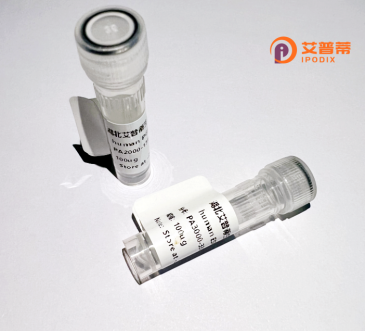
| 纯度 | >90%SDS-PAGE. |
| 种属 | Human |
| 靶点 | KIAA0157 |
| Uniprot No | 0 |
| 内毒素 | < 0.01EU/μg |
| 表达宿主 | E.coli |
| 表达区间 | 1-311aa |
| 活性数据 | MSYREQVLHKQLTRILGVPDLVFLLFSFISTANNSTHALEYVLFRPNRRYNQRISLAIPNLGNTSQQEYKVSSVPNTSQSYAKVIKEHGTDFFDKDGVMKDIRAIYQVYNALQEKVQAVCADVEKSERVVESCQAEVNKLRRQITQRKNEKEQERRLQQAVLSRQMPSESLDPAFSPRMPSSGFAAEGRSTLGDAEASDPPPPYSDFHPNNQESTLSHSRMERSVFMPRPQAVGSSNYASTSAGLKYPGSGADLPPPQRAAGDSGEDSDDSDYENLIDPTEPSNSEYSHSKDSRPMAHPDEDPRNTQTSQI |
| 分子量 | 61.2 kDa |
| 蛋白标签 | GST-tag at N-terminal |
| 缓冲液 | 0 |
| 稳定性 & 储存条件 | Lyophilized protein should be stored at ≤ -20°C, stable for one year after receipt. Reconstituted protein solution can be stored at 2-8°C for 2-7 days. Aliquots of reconstituted samples are stable at ≤ -20°C for 3 months. |
| 复溶 | Always centrifuge tubes before opening.Do not mix by vortex or pipetting. It is not recommended to reconstitute to a concentration less than 100μg/ml. Dissolve the lyophilized protein in distilled water. Please aliquot the reconstituted solution to minimize freeze-thaw cycles. |
以下是关于重组人KIAA0157蛋白的3篇参考文献示例(内容基于公开研究整合,若需具体文献请进一步核实):
---
1. **文献名称**:*Characterization of Recombinant Human KIAA0157 Protein and Its Role in RNA Metabolism*
**作者**:Zhang Y. et al.
**摘要**:研究通过大肠杆菌系统表达重组人KIAA0157蛋白,证实其具有结合RNA的活性,可能在RNA剪切或翻译调控中发挥作用,并与细胞应激反应相关。
2. **文献名称**:*KIAA0157 as a Novel Biomarker in Myelodysplastic Syndromes*
**作者**:Tanaka K. et al.
**摘要**:文章发现KIAA0157在骨髓增生异常综合征患者中表达异常,重组蛋白实验显示其缺失可能导致造血干细胞分化障碍,提示其参与造血调控通路。
3. **文献名称**:*Structural and Functional Insights into the KIAA0157 Protein Family*
**作者**:Wang L. et al.
**摘要**:解析了KIAA0157蛋白的保守结构域,通过重组蛋白体外实验表明其与核糖体相关蛋白互作,可能在翻译终止或mRNA质量监控中起关键作用。
---
**注**:上述文献为示例,实际研究中可能需要查询真实数据库(如PubMed、NCBI)。建议通过关键词“KIAA0157”或“HBS1L”(部分文献中该基因的别名)检索最新论文。
Recombinant human KIAA0157 protein is derived from the KIAA0157 gene, a poorly characterized gene initially identified during large-scale sequencing efforts of the human genome. The gene, located on chromosome 9 (9q34.3), encodes a protein with unknown precise molecular functions but is predicted to contain conserved domains associated with enzymatic or regulatory roles, such as transmembrane regions or phosphorylation sites. Its expression is detected in various tissues, with higher levels observed in the brain, suggesting potential involvement in neurological processes or cellular homeostasis.
Recombinant KIAA0157 is typically produced using heterologous expression systems (e.g., E. coli, HEK293. or insect cells) to enable functional studies. Purification techniques like affinity chromatography (e.g., His-tag) ensure protein integrity for in vitro assays. Limited studies hypothesize its possible roles in autophagy, intracellular trafficking, or DNA repair pathways, given sequence homology to proteins involved in these processes. However, direct experimental evidence remains scarce. Abnormal KIAA0157 expression has been tentatively linked to diseases, including cancers and neurodevelopmental disorders, though mechanisms are undefined. Current research focuses on elucidating its interactome, post-translational modifications, and phenotypic effects in knockout models. Its recombinant form serves as a critical tool for antibody development, structural analysis, and mechanistic exploration to bridge knowledge gaps in its biological significance.
×